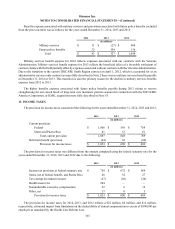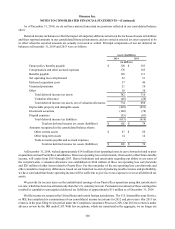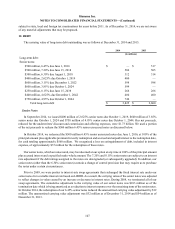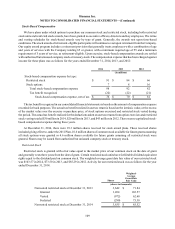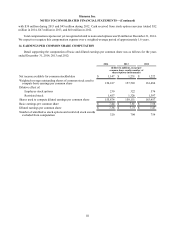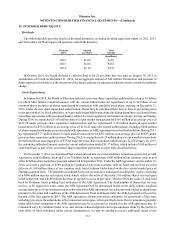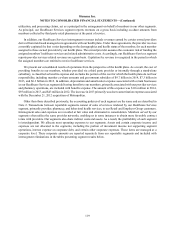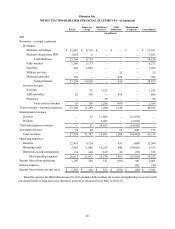Humana 2014 Annual Report Download - page 123
Download and view the complete annual report
Please find page 123 of the 2014 Humana annual report below. You can navigate through the pages in the report by either clicking on the pages listed below, or by using the keyword search tool below to find specific information within the annual report.Humana Inc.
NOTES TO CONSOLIDATED FINANCIAL STATEMENTS—(Continued)
115
in which the contract would end. All material contracts between Humana and CMS relating to our Medicare products
have been renewed for 2015, and all of our product offerings filed with CMS for 2015 have been approved.
CMS uses a risk-adjustment model which apportions premiums paid to Medicare Advantage, or MA, plans
according to health severity of covered members. The risk-adjustment model pays more for enrollees with predictably
higher costs. Under this model, rates paid to MA plans are based on actuarially determined bids, which include a process
whereby our prospective payments are based on a comparison of our beneficiaries’ risk scores, derived from medical
diagnoses, to those enrolled in the government’s traditional fee-for-service Medicare program (referred to as "Medicare
FFS"). Under the risk-adjustment methodology, all MA plans must collect and submit the necessary diagnosis code
information from hospital inpatient, hospital outpatient, and physician providers to CMS within prescribed deadlines.
The CMS risk-adjustment model uses the diagnosis data to calculate the risk-adjusted premium payment to MA plans,
which CMS adjusts for coding pattern differences between the health plans and the government fee-for-service program.
We generally rely on providers, including certain providers in our network who are our employees, to code their claim
submissions with appropriate diagnoses, which we send to CMS as the basis for our payment received from CMS under
the actuarial risk-adjustment model. We also rely on these providers to document appropriately all medical data,
including the diagnosis data submitted with claims. In addition, we conduct medical record reviews as part of our data
and payment accuracy compliance efforts, to more accurately reflect diagnosis conditions under the risk adjustment
model. These compliance efforts include the internal contract level audits described in more detail below.
CMS is continuing to perform audits of various companies’ selected MA contracts related to this risk adjustment
diagnosis data. We refer to these audits as Risk-Adjustment Data Validation Audits, or RADV audits. RADV audits
review medical records in an attempt to validate provider medical record documentation and coding practices which
influence the calculation of premium payments to MA plans.
In 2012, CMS released a “Notice of Final Payment Error Calculation Methodology for Part C Medicare Advantage
Risk Adjustment Data Validation (RADV) Contract-Level Audits.” The payment error calculation methodology
provides that, in calculating the economic impact of audit results for an MA contract, if any, the results of the audit
sample will be extrapolated to the entire MA contract based upon a comparison to “benchmark” audit data in Medicare
FFS (which we refer to as the "FFS Adjuster"). This comparison to the Medicare FFS benchmark audit is necessary to
determine the economic impact, if any, of audit results because the government program data set, including any attendant
errors that are present in that data set, provides the basis for MA plans’ risk adjustment to payment rates. CMS already
makes other adjustments to payment rates based on a comparison of coding pattern differences between MA plans and
Medicare FFS data (such as for frequency of coding for certain diagnoses in MA plan data versus the government
program data set).
The final methodology, including the first application of extrapolated audit results to determine audit settlements,
is expected to be applied to the current round of RADV contract level audits being conducted on 2011 premium payments.
Selected MA contracts will be notified of an audit at some point after the close of the final reconciliation for the payment
year being audited. The final reconciliation occurs in August of the calendar year following the payment year. We have
been notified that certain of our Medicare Advantage contracts have been selected for audit for contract year 2011.
Estimated audit settlements are recorded as a reduction of premiums revenue in our consolidated statements of
income, based upon available information. We perform internal contract level audits based on the RADV audit
methodology prescribed by CMS. Included in these internal contract level audits is an audit of our Private Fee-For-
Service business which we used to represent a proxy of the benchmark audit data in Medicare FFS which has not yet
been released. We based our accrual of estimated audit settlements for contract years 2011 (the first year that application
of extrapolated audit results is applicable) through 2014 on the results of these internal contract level audits and update
our estimates as each audit is completed. Estimates derived from these results were not material to our results of
operations, financial position, or cash flows. However, as indicated, we are awaiting additional guidance from CMS
regarding the benchmark audit data in Medicare FFS. Accordingly, we cannot determine whether such RADV audits
will have a material adverse effect on our results of operations, financial position, or cash flows.
In addition, CMS' comments in formalized guidance regarding “overpayments” to MA plans appear to be
inconsistent with CMS' prior RADV audit guidance. These statements, contained in the preamble to CMS’ final rule
release regarding Medicare Advantage and Part D prescription drug benefit program regulations for Contract Year 2015,


